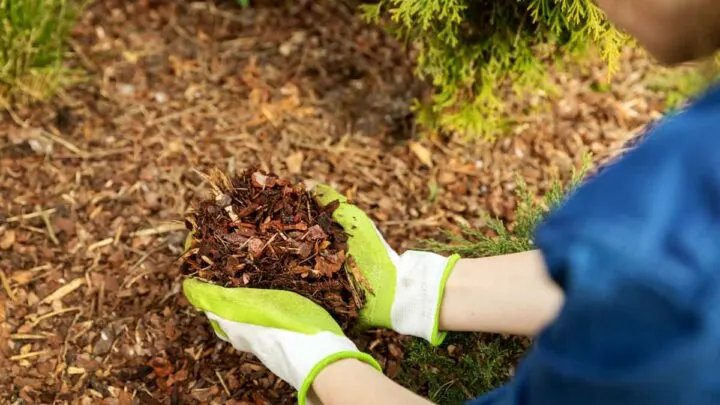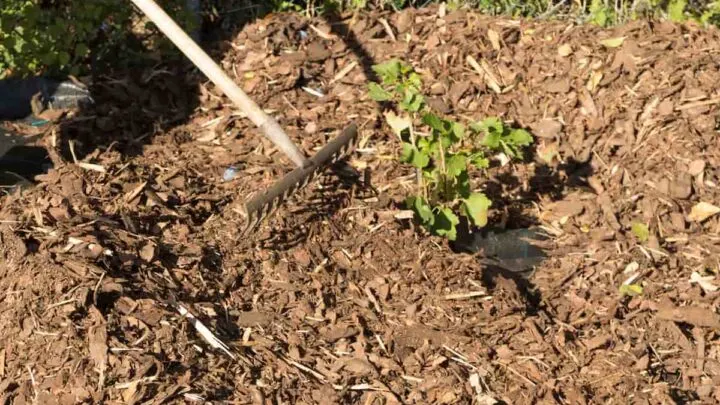There’s nothing more satisfying than a freshly mulched garden. The dark, rich mulch and the colorful plants complement each other well. You can always tell when someone has just laid down new mulch in their garden beds. After a while, you may notice a change in how mulch looks. It loses its freshness and vibrancy. It’s hard to pinpoint the exact change that it makes, but the major shift may lead gardeners to a specific question; does mulch change color?
Over time, mulch changes color. As the top layer of your garden, mulch is exposed to all weather conditions. Rainfall and snow can change their color over time, but the sun does. The sun has a way of drawing color out of materials and making bold colors fade to paler ones.
Luckily, there are ways to refresh mulch to return to its original color. Interestingly enough, there are even specific mulches that hold their color better than others. Keep reading to learn about mulch, how it changes color, and the best ways to restore it to the beautiful color everyone wants in their garden beds.

How Long Does The Color On Mulch Last?
You can expect a basic organic mulch such as wood shavings, compost, and bark to retain its color for an average of one to two seasons or around six months. It depends on how much exposure to sunlight or harsh weather you are receiving where you live. Weather is the main factor in fading mulch, so if you live in an area with milder climates, you can expect your mulch’s color to last a lot longer.
If you purchase a mulch that is dyed black or brown, it can last up to a year. Non-dyed mulches will fade to a gray color in as little as one month. Therefore, it may be smart to consider dyed mulches next time you purchase a new batch of mulch for your garden. The darker, the better; the fading process will be much slower.
Ways to Preserve/Restore The Color Of Mulch
- Rake and turn your mulch. This should be done regularly. By raking it, you are turning up the unfaded mulch from underneath and bringing it to the surface. This can only be done a handful of times before it completely loses its color, but it makes the best use of what you have before replacing it.
- Add another thin layer of mulch to the top of your garden beds. First, you must evaluate how thick the current layer of mulch is. Feel free to sprinkle a thin, fresh layer on top if it’s under two inches. If it’s too thick, you might have to remove some before adding to it. You don’t want to suffocate your plant roots or prevent water from reaching them.
- Pull weeds when you see them pop up. Weeds can speed up the fading process by sucking the nutrients out of your mulch. Garden maintenance is essential, especially when restoring and keeping the color of your mulch.
- Purchase a spray-on colorant. You will likely find this product at your local home and garden store. Spray-on colorants will give your mulch the appearance of its original color. Most of them are non-toxic and will not harm your plants, but do your research to ensure the ingredients listed on the product label are safe. Some spray-on colors may even include fertilizer to give your soil and plants some extra nutrients that they may be lacking.

What Mulch Keeps Its Color?
Rubber Mulch
Rubber mulch is made of ground-up tires and other rubber objects. It’s usually painted a dark brown or red color to make it look like a basic organic mulch. Rubber doesn’t decompose into the Earth; therefore, it will look the same from the time it’s laid for years to come and doesn’t have to be frequently raked or replaced.
Rubber mulch prevents an excessive amount of weeds from growing, and its durability can withstand some harsh weather. The only downsides are that it can be pricey initially and may not pair well with some plants. Rubber can have chemicals on it that can be released into the soil.
Rocks
Small pebbles and gravel can be used as mulch in your garden and will not fade in color. You can purchase colored rocks if you are going for a particular look. Sadly though, rocks will not add any nutritional value to your plants and can be very difficult to remove from the surface of your soil if you don’t want them anymore. Rocks should only be used as mulch in particular gardens.
Bark nuggets
Bark Nuggets are much bigger in consistency than shredded bark. A nugget of bark will hold its moisture much better than a fine shred of bark, making it slower to dry out and fade. Bark nuggets will still lose their rich color over time, but they will hold onto it longer than shredded barks.

Final Thoughts
Most passionate gardeners not only strive for healthy and thriving plants but also value a beautiful garden. Colorful mulch will always be a great way to nourish your plants and protect them and make your garden beds look better.
There are so many different types of mulches that can be used for all different gardens. Some mulches pair better with specific plants. No matter the mulch you choose, take care of it. Regular maintenance such as raking, watering, and weeding will help preserve the color as long as possible, giving your garden a more sophisticated appearance.
As your mulch fades and loses its last bit of color, replace or refresh it with new mulch. Also, if you have lower maintenance plants, try a rubber or rock mulch to ensure the color will never fade.
Sources:

Hi there, my name is Allie and welcome to my blog; GareningWithAllie!
Much of what you see written here is just our personal experiences with gardening. Along with the content I write here, there is also a unique collection of gardening topics covered by some of our close friends. I hope you find everything you read here to be helpful, informative, and something that can make your gardening journey the most lovely experience ever! With that said, Happy Gardening!
